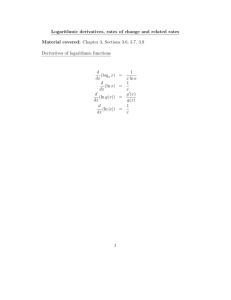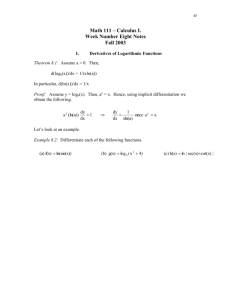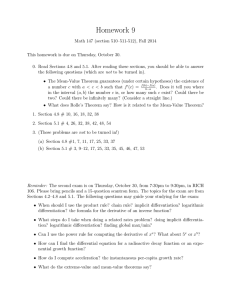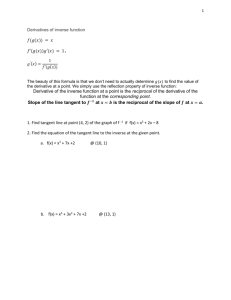Section 4.7: Derivatives of Inverse Functions
advertisement
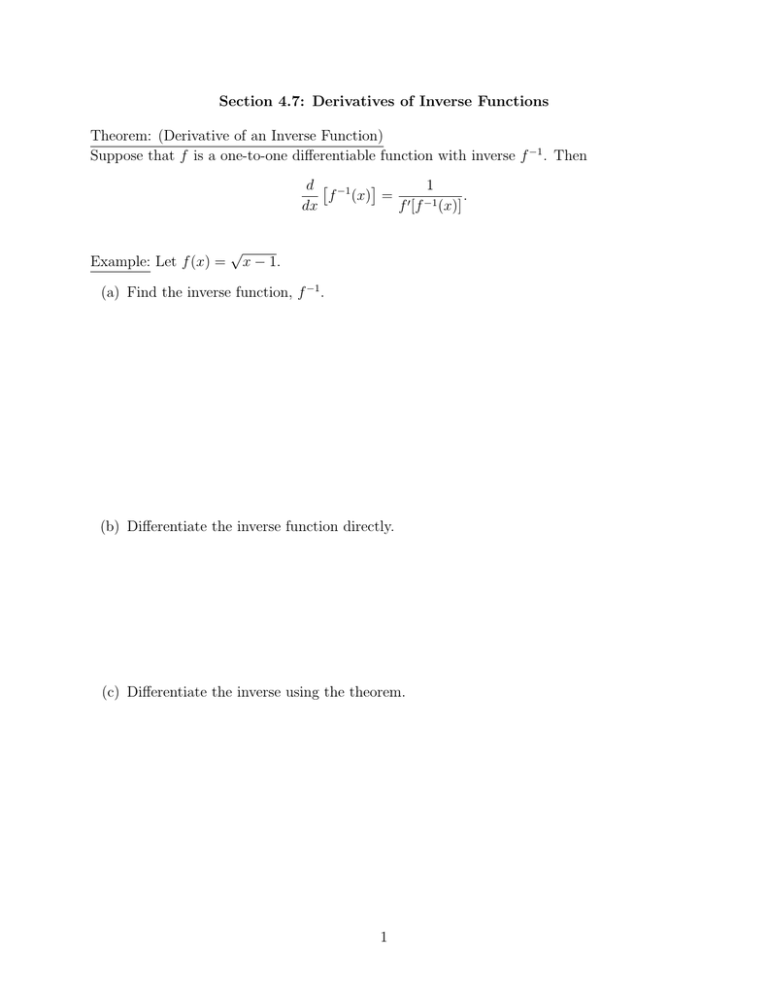
Section 4.7: Derivatives of Inverse Functions Theorem: (Derivative of an Inverse Function) Suppose that f is a one-to-one differentiable function with inverse f −1 . Then d −1 1 f (x) = 0 −1 . dx f [f (x)] Example: Let f (x) = √ x − 1. (a) Find the inverse function, f −1 . (b) Differentiate the inverse function directly. (c) Differentiate the inverse using the theorem. 1 Example: Let f (x) = x5 − x3 + 2x. Find (f −1 )0 (2). (Hint: f (1) = 2) Example: Let f (x) = x − cos x. Find (f −1 )0 (−1). Example: Let f (x) = 3 + x + ex . Find (f −1 )0 (4). 2 Example: Use implicit differentiation to prove that d 1 (ln x) = . dx x Theorem: (Derivative of the Natural Logarithm) d 1 (ln x) = dx x By the Chain Rule, it follows that f 0 (x) d ln(f (x)) = . dx f (x) Example: Differentiate each function. (a) f (x) = ln(3x2 + 2x − 6) (b) f (x) = ln(cos x) 3 (c) f (x) = √ ln x (d) f (x) = ln(x + ln x) (e) f (x) = ln x x2 + 1 4 Example: Use the change of base formula to prove that d 1 (loga x) = . dx x ln a Theorem: (Derivative of a General Logarithm) d 1 (loga x) = dx x ln a By the Chain Rule, it follows that f 0 (x) d [loga (f (x))] = . dx f (x) ln a Example: Differentiate each function. (a) f (x) = log3 (5 − x4 ) (b) f (x) = log(3x3 − x + 2) 5 Example: Use implicit differentiation to find the derivative of y = sin−1 x. Theorem: (Derivatives of Inverse Trigonometric Functions) d 1 (sin−1 x) = √ dx 1 − x2 1 d (cos−1 x) = − √ dx 1 − x2 1 d (tan−1 x) = 2 dx x +1 Example: Differentiate f (x) = tan−1 (3x2 ) + sin−1 (2x + 1) − cos−1 (ln x). 6 Logarithmic Differentiation r 3x + 2 Example: Find the derivative of f (x) = ln . 3x − 2 Note: To compute derivatives of complicated functions involving products, quotients, or powers can be simplified by taking logarithms. This method is known as logarithmic differentiation. Example: Differentiate each function using logarithmic differentiation. (a) f (x) = xsin x 7 (b) g(x) = (ln x)x √ ex x4 + 2 (c) f (x) = (x + 1)4 (x2 + 3)2 8


